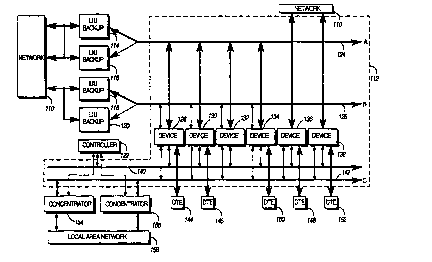Some of the information on this Web page has been provided by external sources. The Government of Canada is not responsible for the accuracy, reliability or currency of the information supplied by external sources. Users wishing to rely upon this information should consult directly with the source of the information. Content provided by external sources is not subject to official languages, privacy and accessibility requirements.
Any discrepancies in the text and image of the Claims and Abstract are due to differing posting times. Text of the Claims and Abstract are posted:
| (12) Patent Application: | (11) CA 2171456 |
|---|---|
| (54) English Title: | ADVANCED COMMUNICATION SYSTEM ARCHITECTURE |
| (54) French Title: | ARCHITECTURE DE SYSTEME DE COMMUNICATION EVOLUEE |
| Status: | Deemed Abandoned and Beyond the Period of Reinstatement - Pending Response to Notice of Disregarded Communication |
| (51) International Patent Classification (IPC): |
|
|---|---|
| (72) Inventors : |
|
| (73) Owners : |
|
| (71) Applicants : | |
| (74) Agent: | GOWLING WLG (CANADA) LLP |
| (74) Associate agent: | |
| (45) Issued: | |
| (86) PCT Filing Date: | 1995-06-28 |
| (87) Open to Public Inspection: | 1996-02-15 |
| Examination requested: | 1996-03-08 |
| Availability of licence: | N/A |
| Dedicated to the Public: | N/A |
| (25) Language of filing: | English |
| Patent Cooperation Treaty (PCT): | Yes |
|---|---|
| (86) PCT Filing Number: | PCT/US1995/008112 |
| (87) International Publication Number: | WO 1996004763 |
| (85) National Entry: | 1996-03-08 |
| (30) Application Priority Data: | ||||||
|---|---|---|---|---|---|---|
|
A communication system for coupling a plurality of data terminals (144, 146, 148, 10, 152) to a telephone network has a time division
multiplexed telephone network access bus (124), providing a plurality of time division slots containing data, coupled to the telephone
network (110), and a digital terminal access bus coupled to the plurality of communication devices (128, 130, 132, 134, 136, 138), each
communication device being configurable to access any of the time division slots. A controller (122) configures each communication device
to access a time division slot.
L'invention concerne un système de communication permettant de coupler une pluralité de terminaux de transmission de données (144, 146, 148, 10, 152) à un réseau téléphonique. Ce système comporte un bus d'accès (124) de réseau téléphonique à multiplexage par répartition dans le temps ayant une pluralité de voies temporelles contenant des données, couplé au réseau téléphonique (110). Il comporte également un bus d'accès aux terminaux numériques couplé aux dispositifs de communication (128, 130, 132, 134, 136, 138), chaque dispositif pouvant être configuré pour accéder à n'importe quelle voie temporelle. Un contrôleur (122) assure la configuration de chaque dispositif de communication lui permettant d'accéder à une voie temporelle.
Note: Claims are shown in the official language in which they were submitted.
Note: Descriptions are shown in the official language in which they were submitted.

2024-08-01:As part of the Next Generation Patents (NGP) transition, the Canadian Patents Database (CPD) now contains a more detailed Event History, which replicates the Event Log of our new back-office solution.
Please note that "Inactive:" events refers to events no longer in use in our new back-office solution.
For a clearer understanding of the status of the application/patent presented on this page, the site Disclaimer , as well as the definitions for Patent , Event History , Maintenance Fee and Payment History should be consulted.
| Description | Date |
|---|---|
| Inactive: IPC expired | 2022-01-01 |
| Inactive: IPC from PCS | 2022-01-01 |
| Inactive: IPC from MCD | 2006-03-12 |
| Inactive: IPC from MCD | 2006-03-12 |
| Inactive: IPC from MCD | 2006-03-12 |
| Inactive: IPC from MCD | 2006-03-12 |
| Inactive: IPC from MCD | 2006-03-12 |
| Inactive: IPC from MCD | 2006-03-12 |
| Time Limit for Reversal Expired | 1998-06-29 |
| Application Not Reinstated by Deadline | 1998-06-29 |
| Deemed Abandoned - Failure to Respond to Maintenance Fee Notice | 1997-06-30 |
| Request for Examination Requirements Determined Compliant | 1996-03-08 |
| All Requirements for Examination Determined Compliant | 1996-03-08 |
| Application Published (Open to Public Inspection) | 1996-02-15 |
| Abandonment Date | Reason | Reinstatement Date |
|---|---|---|
| 1997-06-30 |
Note: Records showing the ownership history in alphabetical order.
| Current Owners on Record |
|---|
| MOTOROLA, INC. |
| Past Owners on Record |
|---|
| CHARLES E., JR. POLK |
| DAVID EARL WILDER |
| DAVID PAUL NELSON |
| STEVEN R. BLACKWELL |